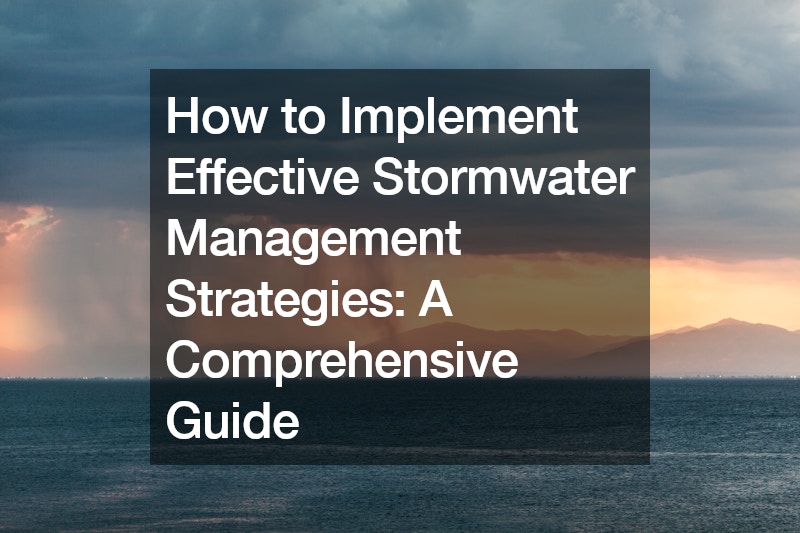Stormwater runoff – the rainwater that flows across impervious surfaces like rooftops and pavement – can pose a significant challenge for businesses. Uncontrolled runoff can lead to flooding, erosion, and water pollution. However, by implementing effective stormwater management strategies, businesses can not only comply with environmental regulations but also reap various financial and environmental benefits.
This comprehensive guide explores the importance of stormwater management for businesses and equips you with practical strategies to minimize your environmental impact and protect your property.
Understanding the Problem:
Environmental Impact: Uncontrolled stormwater runoff carries pollutants like fertilizers, pesticides, oil, and grease from parking lots and roads into nearby waterways. This can harm aquatic ecosystems and degrade water quality.
Flooding Risks: Heavy rainfall events can overwhelm traditional drainage systems, leading to flooding that can damage buildings, equipment, and inventory. Erosion: Stormwater runoff can erode soil, leading to landscaping damage and potential structural problems for buildings. The Business Case for Effective Stormwater Management:
While stormwater management requires some upfront investment, the long-term benefits outweigh the costs:
Compliance with Regulations: Many regions have strict stormwater management regulations for commercial properties. Implementing effective practices ensures compliance and avoids potential fines. Reduced Flood Risks: By mitigating flood risks, businesses can protect their property, equipment, and inventory from costly water damage. Lowered Insurance Premiums: Some insurance companies offer discounts for businesses with effective stormwater management plans. Improved Brand Image: Demonstrating environmental responsibility through sustainable practices can enhance your brand image and attract eco-conscious customers. Developing a Stormwater Management Plan:
The first step towards effective stormwater management is creating a comprehensive plan. Here’s what to consider:
Site Assessment: Evaluate your property’s size, topography, and existing drainage systems. Identify potential pollution sources and areas prone to flooding or erosion. Regulatory Review: Research and understand local and regional stormwater regulations to ensure your plan adheres to all compliance requirements. Best Management Practices (BMPs): Select a combination of BMPs that best suit your property and budget. Examples of BMPs include Green Infrastructure, Utilizing natural elements like rain gardens, bioswales, and permeable pavements to filter and infiltrate rainwater into the ground. Detention Ponds: Constructed ponds that temporarily store stormwater runoff to reduce peak flow rates and prevent flooding. Retention Ponds: Ponds are designed to permanently store a specific volume of stormwater, often used for irrigation or water reuse. Vegetated Filter Strips: Planting vegetation along slopes and drainage pathways to filter pollutants and slow down runoff. Storm Drain Stenciling: Marking storm drains with messages highlighting the connection to waterways can raise awareness of stormwater pollution. Implementing and Maintaining Your Plan:
Prioritize Prevention: Focus on strategies that prevent stormwater runoff at its source. Consider practices like rooftop gardens, rain barrels, and disconnecting downspouts to direct rainwater toward landscaping. Regular Maintenance: Schedule regular inspections and maintenance for your chosen BMPs to ensure they function effectively. This might include cleaning filters, removing debris, and replacing vegetation. Employee Training: Educate employees about the importance of stormwater management and how their daily practices can contribute. Encourage them to report any potential pollution sources or maintenance issues. Additional Considerations:
Cost-Effectiveness: Evaluate the cost-effectiveness of different BMPs and prioritize those that offer long-term cost savings through reduced maintenance needs and potential insurance discounts. Aesthetics: Consider incorporating green infrastructure like rain gardens or bioswales that can enhance the aesthetics of your property while providing stormwater management benefits. Community Collaboration: Explore opportunities to collaborate with neighboring businesses or community organizations to implement joint stormwater management solutions that benefit everyone. Conclusion:
Effective stormwater management is no longer just an environmental responsibility; it’s a smart business decision. By implementing a comprehensive plan that utilizes a combination of BMPs, businesses can minimize their environmental footprint, protect their property, and contribute to a healthier community.
Embrace Sustainability:
Start your journey towards sustainable stormwater management today. Remember, every drop counts and every action you take can make a positive difference. With careful planning, strategic implementation, and ongoing maintenance, businesses can become responsible stewards of the environment while ensuring long-term success. The Future of Stormwater Management:
As climate change brings more frequent and intense storms, effective stormwater management will become even more critical for businesses. Here’s a glimpse into what the future holds:
Technological Advancements: New technologies like smart sensors and real-time monitoring systems will enable better data collection and improve the efficiency of stormwater management practices. Green Infrastructure Integration: Green infrastructure solutions like rain gardens and bioswales will likely become more commonplace, offering aesthetic appeal alongside stormwater management benefits. Regulatory Landscape: Stormwater regulations are expected to become stricter, prompting businesses to adopt more sophisticated and comprehensive management plans. Taking Action:
By staying informed about the latest trends and regulations, businesses can implement effective stormwater management strategies proactively. This proactive approach ensures compliance and positions your business as a leader in environmental sustainability.
Investing in a Sustainable Future:
Remember, stormwater management is an investment in the future. By protecting our water resources today, businesses can ensure a healthy environment for future generations. Start planning, take action, and embrace your role as a responsible steward of the environment.
.

